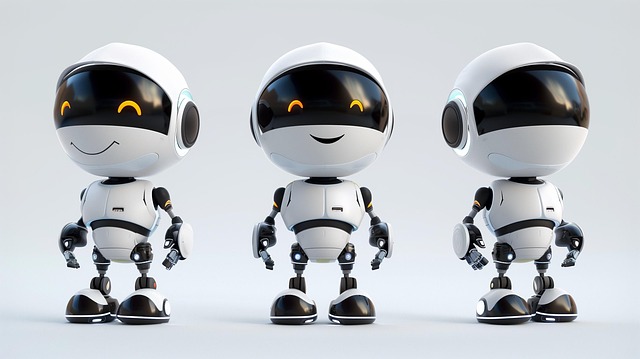“AI chatbots are transforming the way we interact with technology, offering unprecedented levels of personalization and efficiency. This article delves into the multifaceted world of artificial intelligence, exploring its various applications and advancements. We begin by understanding the foundational concepts of AI chatbots and their diverse functionalities. Then, we uncover the creative potential of Generative AI, highlighting recent breakthroughs in language models. Furthermore, we trace the evolution from rule-based systems to Machine Learning-driven agents. Ethical considerations are addressed, followed by a glimpse into the future, where enhanced user experiences redefine human-AI interaction.”
- Understanding AI Chatbots: Their Functionality and Applications
- Generative AI: Unlocking Creative Possibilities with Language Models
- The Evolution of Conversational Agents: From Rule-Based to Machine Learning
- Ethical Considerations in Deploying AI Chatbots and Generative AI Technologies
- Future Trends: Enhancing User Experiences with Advanced AI Chatbot Systems
Understanding AI Chatbots: Their Functionality and Applications

AI chatbots are a form of artificial intelligence designed to engage in conversational interactions with users, mimicking human-like dialogue. They utilise advanced natural language processing (NLP) algorithms to understand and interpret user inputs, enabling them to respond coherently and contextually. These chatbots can be integrated into various applications, enhancing customer service by providing instant support and information 24/7.
Beyond customer service, AI chatbots find applications in diverse fields. They assist in scheduling appointments, offer personalized recommendations for products or services, act as virtual assistants for task management, and even contribute to content generation. The versatility of AI chatbots makes them a valuable tool across industries, revolutionizing how businesses interact with their customers and streamlining various processes.
Generative AI: Unlocking Creative Possibilities with Language Models

Generative AI represents a groundbreaking leap forward in the capabilities of artificial intelligence, particularly for AI chatbots. By leveraging advanced language models, these systems can create original content—from text and art to music and code—that’s remarkably human-like. At its core, generative AI operates by analyzing vast amounts of data to identify patterns and structures in human language, allowing it to generate new, coherent outputs that maintain context and nuance.
This technology unlocks a world of creative possibilities for users. For instance, content creators can use generative AI to expedite their workflows, generating draft articles or story ideas quickly. Artists and designers can collaborate with AI chatbots to explore novel concepts and styles. Moreover, the applications extend beyond arts and literature into fields like software development, where AI can assist in coding by suggesting syntax and generating code snippets based on natural language prompts.
The Evolution of Conversational Agents: From Rule-Based to Machine Learning

The evolution of conversational agents has witnessed a remarkable transformation from rule-based systems to the advent of machine learning (ML) and, more recently, generative AI. Early chatbots relied on pre-programmed rules and patterns to respond to user inputs, often resulting in limited conversations that followed rigid paths. These rule-based systems, while innovative for their time, lacked adaptability and could not cater to the diverse and dynamic nature of human language.
The introduction of ML algorithms brought about a paradigm shift, enabling chatbots to learn from vast amounts of data and gain a deeper understanding of user intent. With machine learning, chatbots could process natural language inputs, interpret context, and generate more nuanced responses. This evolution allowed for more fluid conversations, better comprehension, and improved user experiences. As AI chatbots continue to advance with generative AI, they are becoming increasingly sophisticated in their ability to engage in complex interactions, offering personalized assistance, creative content generation, and enhanced problem-solving capabilities.
Ethical Considerations in Deploying AI Chatbots and Generative AI Technologies

As AI chatbots and generative AI technologies become more advanced and integrated into daily life, ethical considerations are paramount. These systems can inadvertently perpetuate biases present in their training data, leading to discriminatory outcomes. For instance, an AI chatbot might reproduce societal stereotypes if trained on biased datasets. Additionally, the potential for misuse is a significant concern; generative AI can create deepfakes or generate convincing but false information, raising issues of trust and misinformation.
Transparency and accountability are crucial in addressing these challenges. Developers must ensure that AI chatbots are trained on diverse, representative data sets to mitigate biases. Implementing robust content moderation and fact-checking mechanisms is essential to prevent the spread of false or harmful content generated by generative AI tools. Furthermore, users should be made aware of an AI chatbot’s capabilities and limitations to foster informed interactions.
Future Trends: Enhancing User Experiences with Advanced AI Chatbot Systems

As we move forward into an increasingly digital future, AI chatbot systems are set to become even more sophisticated and integral to our daily lives. Advanced natural language processing (NLP) and machine learning algorithms will enable chatbots to understand complex queries, engage in nuanced conversations, and provide personalized responses tailored to individual users. This evolution promises to enhance user experiences across various sectors, from customer service and healthcare to education and entertainment.
Future trends suggest that AI chatbots will become more than just conversational assistants; they will act as intelligent companions, capable of learning from interactions and anticipating needs. Generative AI, with its ability to create content such as text, images, and even code, will further expand the capabilities of these systems. This fusion of advanced technologies will open up new possibilities for interaction and engagement, fundamentally changing how we access information and conduct our daily tasks.
The evolution of AI chatbots and generative AI marks a transformative phase in human-computer interaction. From understanding their multifaceted applications to exploring the creative potential of language models, these technologies are reshaping industries and enhancing user experiences. As we navigate the ethical landscape and embrace future trends, AI chatbots will undoubtedly continue to revolutionize the way we interact with technology, promising innovative solutions and unprecedented possibilities.
